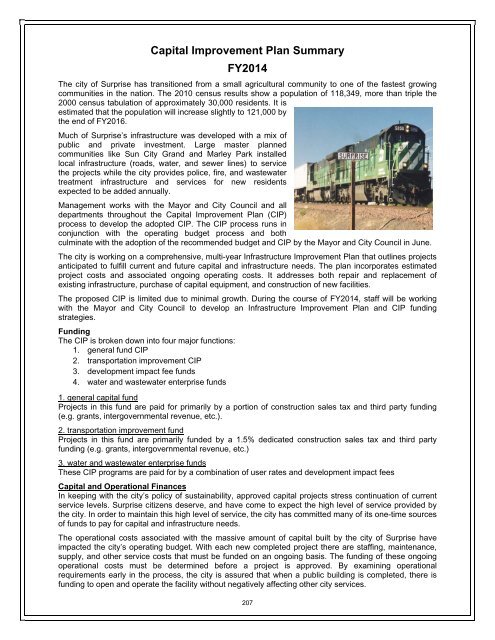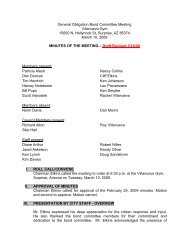FY2014 Recommended Budget - City of Surprise
FY2014 Recommended Budget - City of Surprise
FY2014 Recommended Budget - City of Surprise
You also want an ePaper? Increase the reach of your titles
YUMPU automatically turns print PDFs into web optimized ePapers that Google loves.
Capital Improvement Plan Summary<br />
<strong>FY2014</strong><br />
The city <strong>of</strong> <strong>Surprise</strong> has transitioned from a small agricultural community to one <strong>of</strong> the fastest growing<br />
communities in the nation. The 2010 census results show a population <strong>of</strong> 118,349, more than triple the<br />
2000 census tabulation <strong>of</strong> approximately 30,000 residents. It is<br />
estimated that the population will increase slightly to 121,000 by<br />
the end <strong>of</strong> FY2016.<br />
Much <strong>of</strong> <strong>Surprise</strong>’s infrastructure was developed with a mix <strong>of</strong><br />
public and private investment. Large master planned<br />
communities like Sun <strong>City</strong> Grand and Marley Park installed<br />
local infrastructure (roads, water, and sewer lines) to service<br />
the projects while the city provides police, fire, and wastewater<br />
treatment infrastructure and services for new residents<br />
expected to be added annually.<br />
Management works with the Mayor and <strong>City</strong> Council and all<br />
departments throughout the Capital Improvement Plan (CIP)<br />
process to develop the adopted CIP. The CIP process runs in<br />
conjunction with the operating budget process and both<br />
culminate with the adoption <strong>of</strong> the recommended budget and CIP by the Mayor and <strong>City</strong> Council in June.<br />
The city is working on a comprehensive, multi-year Infrastructure Improvement Plan that outlines projects<br />
anticipated to fulfill current and future capital and infrastructure needs. The plan incorporates estimated<br />
project costs and associated ongoing operating costs. It addresses both repair and replacement <strong>of</strong><br />
existing infrastructure, purchase <strong>of</strong> capital equipment, and construction <strong>of</strong> new facilities.<br />
The proposed CIP is limited due to minimal growth. During the course <strong>of</strong> <strong>FY2014</strong>, staff will be working<br />
with the Mayor and <strong>City</strong> Council to develop an Infrastructure Improvement Plan and CIP funding<br />
strategies.<br />
Funding<br />
The CIP is broken down into four major functions:<br />
1. general fund CIP<br />
2. transportation improvement CIP<br />
3. development impact fee funds<br />
4. water and wastewater enterprise funds<br />
1. general capital fund<br />
Projects in this fund are paid for primarily by a portion <strong>of</strong> construction sales tax and third party funding<br />
(e.g. grants, intergovernmental revenue, etc.).<br />
2. transportation improvement fund<br />
Projects in this fund are primarily funded by a 1.5% dedicated construction sales tax and third party<br />
funding (e.g. grants, intergovernmental revenue, etc.)<br />
3. water and wastewater enterprise funds<br />
These CIP programs are paid for by a combination <strong>of</strong> user rates and development impact fees<br />
Capital and Operational Finances<br />
In keeping with the city’s policy <strong>of</strong> sustainability, approved capital projects stress continuation <strong>of</strong> current<br />
service levels. <strong>Surprise</strong> citizens deserve, and have come to expect the high level <strong>of</strong> service provided by<br />
the city. In order to maintain this high level <strong>of</strong> service, the city has committed many <strong>of</strong> its one-time sources<br />
<strong>of</strong> funds to pay for capital and infrastructure needs.<br />
The operational costs associated with the massive amount <strong>of</strong> capital built by the city <strong>of</strong> <strong>Surprise</strong> have<br />
impacted the city’s operating budget. With each new completed project there are staffing, maintenance,<br />
supply, and other service costs that must be funded on an ongoing basis. The funding <strong>of</strong> these ongoing<br />
operational costs must be determined before a project is approved. By examining operational<br />
requirements early in the process, the city is assured that when a public building is completed, there is<br />
funding to open and operate the facility without negatively affecting other city services.<br />
207




